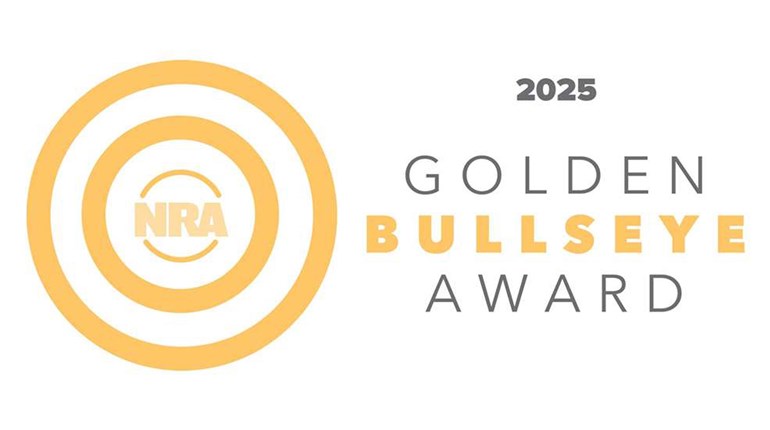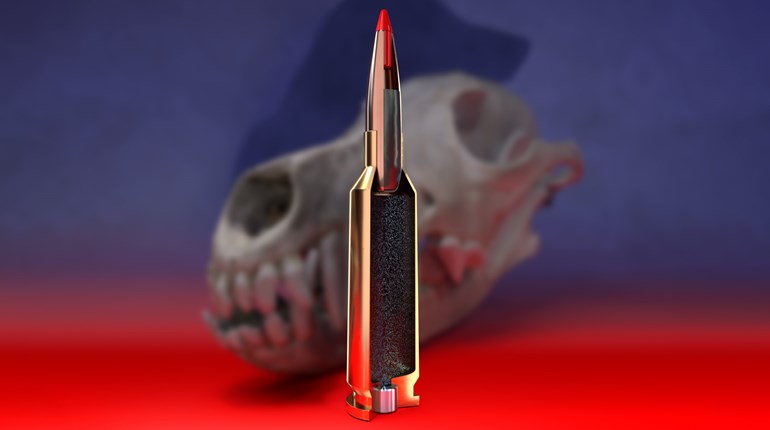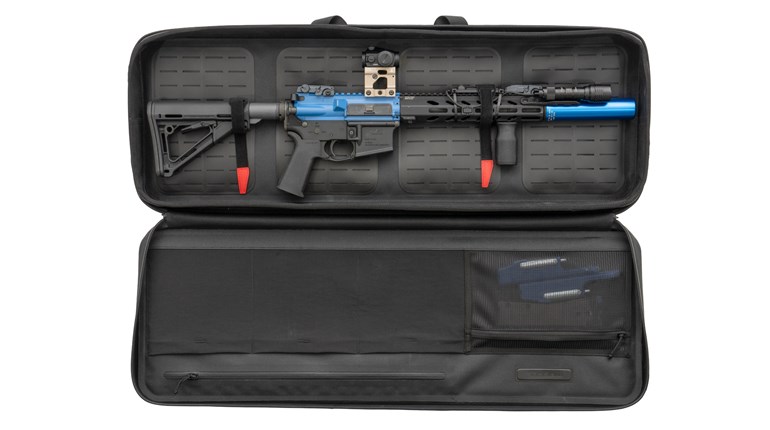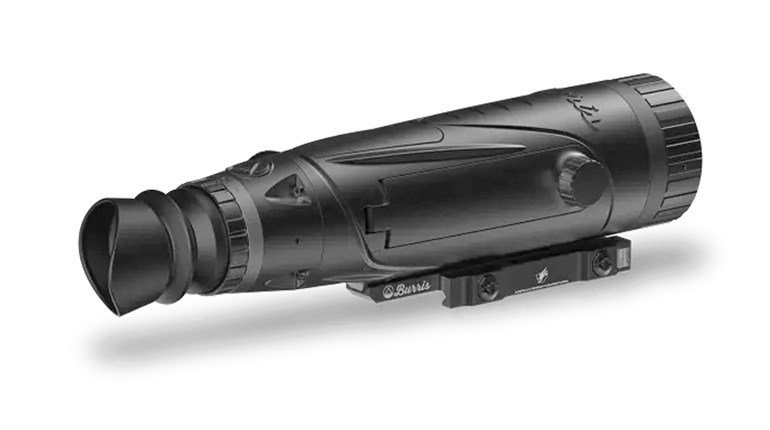
Whacking targets at stupidly long ranges has become the cool thing to do. Indeed, it's gratifying to get behind a rifle, fire a single shot and hit a target the size of a guitar five football fields away. For many, this mastery of ballistics and pulling triggers seems as complicated as calculus and as expensive as an addiction. It doesn't have to be that way. In fact, even an average rifleman with about $3,000 in equipment can be deadly efficient out to 500 yards, with no training at all.

Look at the gear many suggest you need for long-range shooting, and you'll quickly see why the experts think we're all trust-fund kids with money to burn. There's no question the tools of the long-range shooting trade have become highly sophisticated and amazingly precise. They can also be overly complicated for the fellow who just wants to hit the range every month or so and impress onlookers.
Most modern long-range tools are designed for practiced military snipers. If that's who you are, you're wasting your time reading this; go play X-Box or watch "The Bachelorette." This article is a reality show for real folks. With the right equipment, real, average guys can be just as effective out to 500 yards as most wannabe ninja operatives who call themselves a sniper—even if they have been to high-dollar, long-range shooting schools.
The Gear
You're gonna need a rifle, and rifles can be expensive. I recently tested a very fine-shooting, custom sniper rifle that could repeatedly put five shots into a single hole at 100 yards. That rifle cost almost $4,000. I cannot afford a four-grand rifle, and the fact is, you don't need a high-dollar model. If you want one and have the money, go for it. I have three kids and a mortgage, so I took a more practical approach and chose a Remington Model 700 SPS Tactical AAC-SD in .308 Win. Suggested retail: $780. Street price: $645.

With the Black Hills 175-grain Match hollow-point load, this rifle shoots astoundingly well; just as well as the four-grand custom rifle. Combine this precision with a 1:10-inch twist, 20-inch heavy barrel (which also has a threaded muzzle), a Hogue OverMolded Pillar Bed Ghillie Green Stock and Remington's externally adjustable X-Mark Pro trigger—which felt every bit as good as a Timney—and you've got yourself an incomparable bargain when it comes to precision rifles.
You'll need accessories, too. For starters, there's the bipod. Harris bipods have been the industry standard for a long time, and that's the route I went. Serious long-range rifle work is conducted from the prone position, and from there, a 6- to 9-inch bipod is ideal. Both fixed and swivel versions are available. The latter offers a bit more leeway in positioning, but it's not a must. I chose the fixed version and Brownells had one headed my way for $80.
A butt-cuff or cheek rest is a good idea, too. It positions your eye properly behind the scope and provides storage for extra ammo and important accessories. Shop around and find one you like. I selected the IVS Performance Cheek Pad from Blackhawk. It's adjustable, and you can build up under it to create an optimal cheek weld. It also holds five cartridges externally and has a generous storage pocket that comes in handy.
Finally, you're going to need a sighting system, otherwise known as a riflescope. The selection of the proper optic is the key to my tacti-simple long-range concept. Most tactical riflescopes have a mil-dot reticle, which is a very effective tool for long-range shooting, but can be confusing without a good deal of study and routine use. Also, it's best suited to working with a spotter—who can give the shooter corrections in mils—and most average guys don't have a skilled spotter to take with them to the range. Your girlfriend does not count.
There are bookoo long-range reticles in varied configurations, however. They all work. The problem is, many are as hard to decipher as Sudoku puzzle. You need to use them often to be able to employ them with efficiency and speed. Most tactical riflescopes also come with target turrets, which are elevated windage and elevation adjustments with 1/4-MOA or .1-mil clicks. These turrets help you to dial in your hits at long range, but you have to know how many clicks to make at any given range.

I'm sorry: my life is already confusing enough. I spend a half-hour each day arguing with my smartphone. Leupold's CDS (Custom Dial System) riflescope seemed like the hillbilly solution to the physics problems of long-range shooting. This riflescope utilizes a common duplex reticle and custom elevation dials, which have been marked to match the trajectory profile of your ammo from your rifle. If you want to hit at 400 yards, you turn the dial to "4" and shoot. Stupid simple!
The CDS concept works because you actually go to the range and chronograph your ammo to determine an average muzzle velocity. Then, just send that velocity, along with some other information, to Leupold and it will custom engrave a turret for your new scope. This is precisely what I did using the Black Hills 175-grain load, which averaged 2,525 fps from my Remington SPS Tactical at 2,200 feet above sea level. Leupold created an elevation dial to match that trajectory. Cost: $875.
Obviously, a riflescope has to be mounted, and the mount has to be solid. I learned a long time ago not to skimp on scope mounts—no matter what—so Leupold's Mark 4 rings, which are also used by military and police snipers, were the logical choice. However, instead of going with a two-piece base, I chose a one-piece Leupold Mark 4 base that has a 15-MOA cant built in. This offset ensured I would have plenty of adjustment to zero the riflescope and still dial in a 500-yard trajectory correction. Cost: $359.
The last piece of gear needed was something to help me estimate range. Most tactards and professional snipers use the mil-dot reticle to estimate range. By comparing the size of known objects to the reticle and working a math problem, this is an effective method. I do enough math at tax time to last me all year, so I wanted a simpler solution. I found it for $399: Leupold's RX-1000i TBR with DNA Digital Laser Rangefinder.
No more guessing and no more math. I've yet to point this at a target inside of 600 yards and not get a solid reading. Additionally, with True Ballistic Ranging (TBR) technology, compensation is made for the angle to the target, so it does not matter if you're shooting at steep angles, up or down. Just put it on target and push a button. Also, the unit fits inside the accessory pouch on the Blackhawk IVS Performance Cheek Pad.
Proper Application
The heavy-barreled rifle with a good trigger, bipod and cheek piece provides a comfortable and solid platform. Fantastic optics in the Leupold VX-3L scope give a crisp view of the target and the RX-1000i rangefinder will tell you target distance. Once in position with a known range to target, simply dial in the distance. The only thing left to consider is wind. As complicated as correcting for wind can be, there's a simple trick.
Let's say you're shooting at an IPSC silhouette target at 500 yards. Side to side, this target will measure 18 inches. Wind is rarely full value, and even more rarely is it constant from muzzle to target. But, let's assume you have a constant, full-value 5-mph wind. It will cause a 175-grain SMK .308 Win. bullet with a muzzle velocity of 2,525 fps to drift about 12.5 inches at 500 yards. Your correction is simple: If the wind is left to right, hold on the target's left edge.
What if you miss? Assuming you ranged the target correctly and didn't bugger the shot, your miss was due to wind. If it is indeed blowing left to right and you held on the left edge, yet still missed, you misjudged wind velocity. So, take a calculated guess. When dealing with a known wind direction but an unknown velocity, the correction is always a half target. In other words, you hold a half-target more into the wind.

In this instance, with the 18-inch IPSC target, you'll now be holding a half target (9 inches) to the left. If the wind is double your initial guess of 5 mph, your bullet will drift about 20 inches to the right. Since you're holding 9 inches left, on an 18-inch target, the bullet should strike about 2 inches right of center.
It's really a simple process. If you think there's no wind, hold center. If you miss, correct with a half-target hold in the direction you think the wind might be coming from. If you're already holding a half-target into the wind and miss, make another half-target correction. Granted, if you see the bullet splash off to one side of the target, simply correct an equal amount in the opposite direction.
Does It Work?
There was only one way to find out if my long-range tacti-simple approach works. I precisely zeroed my Model 700 SPS at 100 yards with the 175-grain Black Hills load and set the custom CDS dial to zero. I then went to a large crop field near my home, set up a target and limited my test to five shots: one shot each from 100, 200, 300, 400 and 500 yards. I figured a miss at any range would constitute failure.
There was no failure. Every shot was a hit. Not a perfect, dead-center hit, but a hit. On the day I put these simple methods to the test, the wind was gusting from about 4 o'clock at an estimated 3 to 7 mph. To compensate, I held dead on at 100, 200 and 300 yards, and on the target's left edge at 400 and 500 yards.
So there you have it. A $3,000 solution to long-range shooting that requires you to work no math problems or memorize wind values. The keys are knowing your rifle and zeroing it with a specific load, and then using a bit of technology while keeping it simple.
Of course, even though these techniques are uncomplicated, you still need to practice. Marksmanship fundamentals still apply. Get those down, and the rest will come much easier.
If you really want to be tacti-simple and tacti-cool, you can install an Advanced Armament Corporation suppressor on the threaded muzzle of the Remington 700 SPS Tactical and you won't even need to wear ear protection. It will add about another $700 to your rig, but you'll be able to hear the zombies screaming when you hit them from five football fields away.
|
Gun and Gear |
MSRP |
| Rifle: Remington Model 700 SPS Tactical AAC-SD |
$780.00 |
| Scope: Leupold VX-3L 3.5-10x50mm CDS |
$874.99 |
| Scope Base: Leupold One-Piece Mark 4 with 15-MOA Slope |
$125.00 |
| Rings: Leupold Mark 4 |
$224.00 |
| Bipod: Harris HBR |
$89.65 |
| Range Finder: Leupold's RX-1000i TBR with DNA |
$499.99 |
| Butt Cuff: Blackhawk Performance IVS Cheek Pad |
$44.99 |
| Ammunition: Black Hills 175-grain Match Hollow Point |
$35.00 |
| Target: Tubb Enterprises Tango Stake Target |
$299.99 |
|
Total |
$2,973.61 |







































